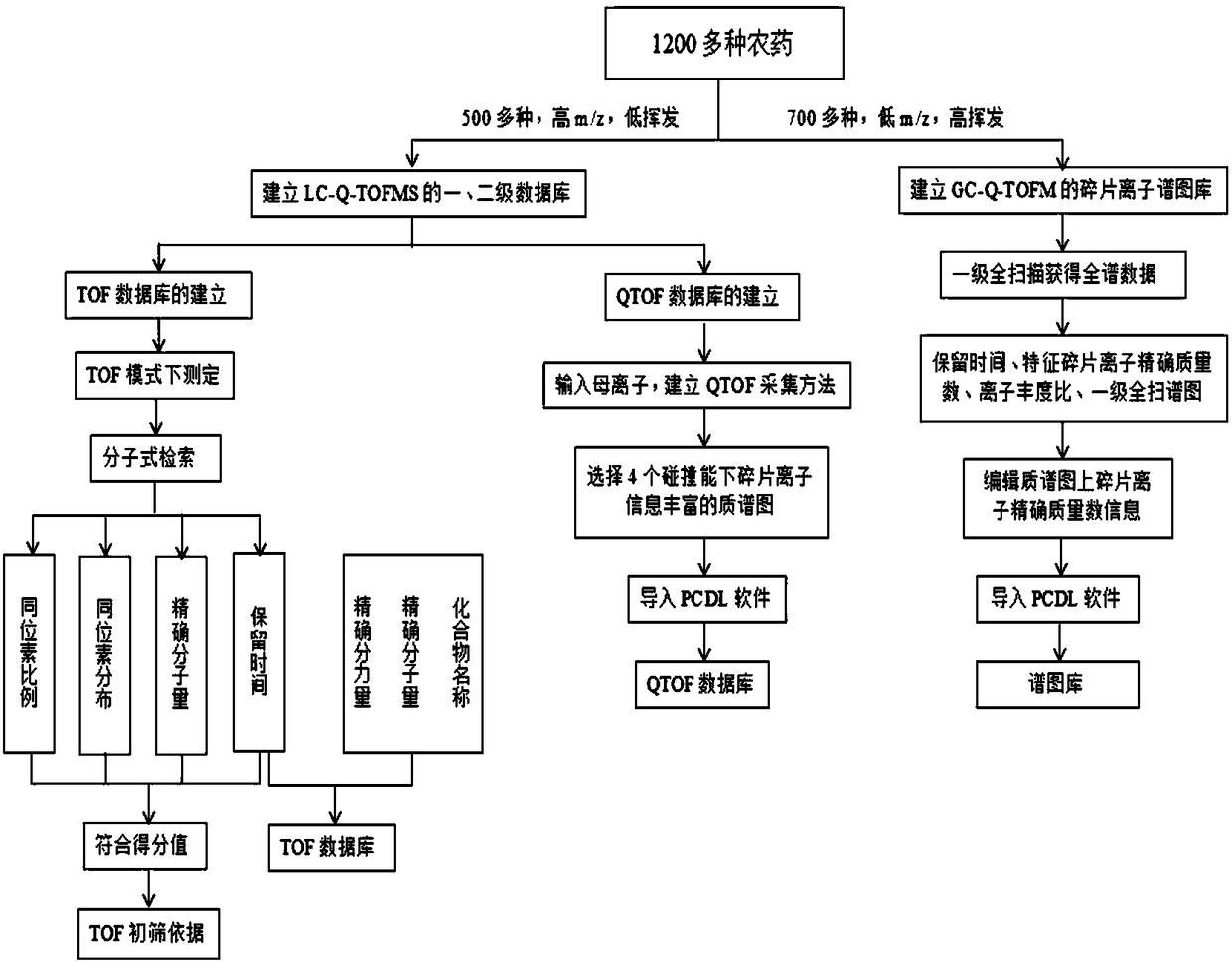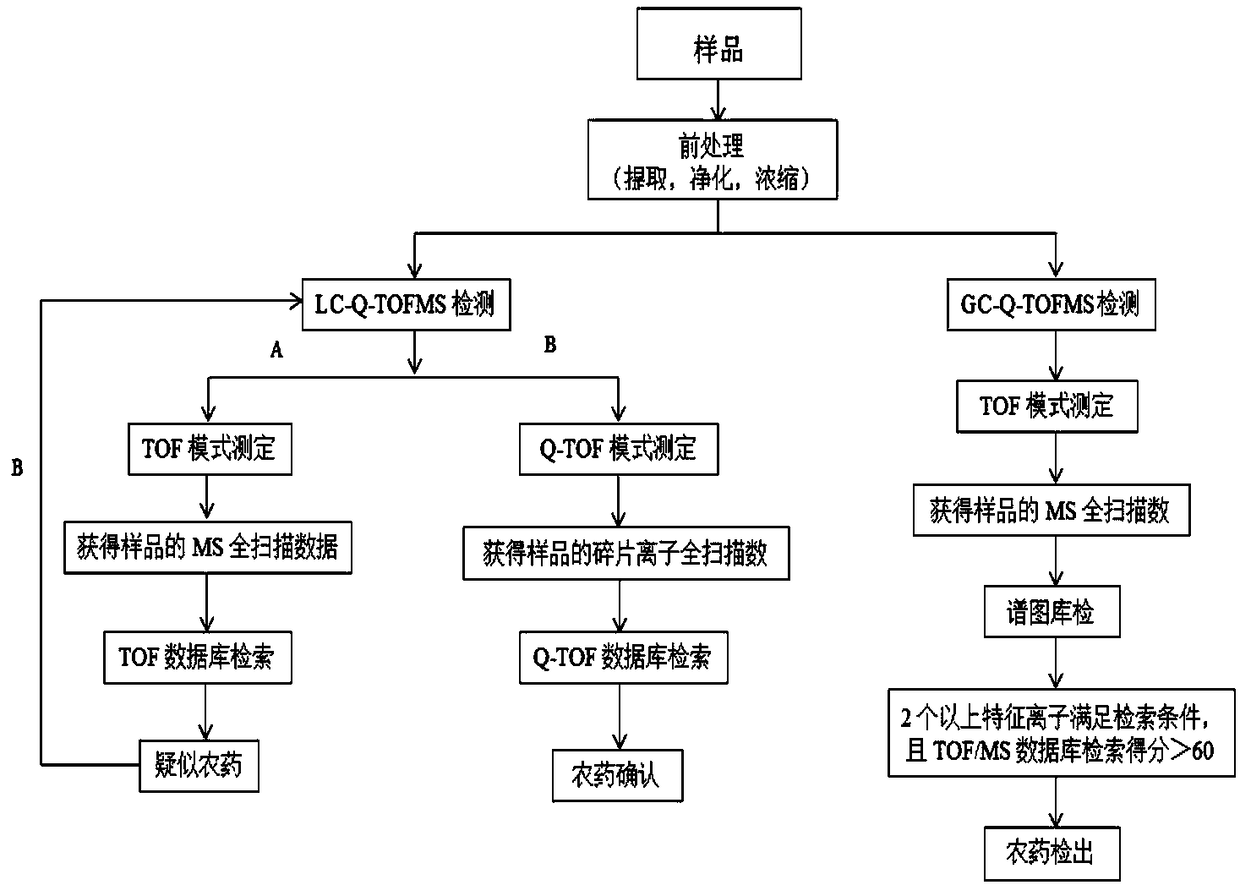An electronic method for non-target multi-index rapid detection of pesticide residues in edible agricultural products
A pesticide residue, non-target technology, applied in the direction of measuring devices, instruments, scientific instruments, etc., can solve the problems of high price, food safety monitoring loopholes, valid period of only 2 or 3 years, etc., to achieve rapid detection and improve performance.
- Summary
- Abstract
- Description
- Claims
- Application Information
AI Technical Summary
Problems solved by technology
Method used
Image
Examples
Embodiment
[0072] More than 1,200 kinds of pesticides in celery (for specific pesticide types, please refer to the pesticides listed in the two patents with publication numbers CN105738460A and CN105628839A) LC-Q-TOF / MS and GC-Q-TOF / MS detection and confirmation technology implementation examples, Including the following steps;
[0073] 1. Specific steps of sample pretreatment technology:
[0074] 1.1 Take the edible part of the celery sample, chop it up, mix it evenly, seal it, and mark it;
[0075] 1.2 Weigh 10g of celery sample (accurate to 0.01g), add 40mL of 1% acetic acid acetonitrile into an 80mL centrifuge tube, use a high-speed homogenizer at 13500r / min, homogenize and extract for 1min, add 1g of sodium chloride, 4g of anhydrous sulfuric acid Magnesium, shake for 5min, centrifuge at 4200r / min for 5min, take 20mL of the supernatant, concentrate it to about 1mL by rotary evaporation in a water bath at 40°C, and wait for purification.
[0076] 1.3 Add about 2cm high anhydrous sod...
Embodiment 2
[0094] Implementation examples of LC-Q-TOF / MS and GC-Q-TOF / MS detection and confirmation techniques for more than 1,200 pesticides in tomato (such as the pesticides described above).
[0095] The sample pretreatment steps, LC-Q-TOF / MS and GC-Q-TOF / MS operating conditions, and the detection process of pesticide residues in samples are all referred to in Example 1.
[0096] LC-Q-TOF / MS and GC-Q-TOF / MS detection results in tomato samples in a provincial capital city: 19 commercially available tomato samples in a provincial capital city were collected, and LC-Q-TOF / MS and GC-Q-TOF were used LC-Q-TOF / MS and GC-Q-TOF / MS technologies detected 37 kinds of pesticide residues, with a total of 141 frequencies involving 19 samples. The specific results are shown in Table 2.
[0097] Table 2 Detection results of LC-Q-TOF / MS and GC-Q-TOF / MS in tomato samples from a certain area
[0098]
Embodiment 3
[0100] Implementation examples of LC-Q-TOF / MS and GC-Q-TOF / MS detection and confirmation techniques for more than 1,200 pesticides in grapes (such as the pesticides described above).
[0101] The sample pretreatment steps, LC-Q-TOF / MS and GC-Q-TOF / MS operating conditions, and the detection process of pesticide residues in samples are all referred to in Example 1.
[0102] LC-Q-TOF / MS and GC-Q-TOF / MS detection results in grape samples in a provincial capital city: 17 commercially available grape samples in a provincial capital city were collected, and LC-Q-TOF / MS and GC-Q-TOF were used LC-Q-TOF / MS and GC-Q-TOF / MS technologies detected 39 kinds of pesticide residues, with a total of 147 frequencies involving 16 samples. The specific results are shown in Table 3.
[0103] Table 3 Detection results of LC-Q-TOF / MS and GC-Q-TOF / MS in grape samples in a certain area
[0104]
PUM
 Login to View More
Login to View More Abstract
Description
Claims
Application Information
 Login to View More
Login to View More - R&D
- Intellectual Property
- Life Sciences
- Materials
- Tech Scout
- Unparalleled Data Quality
- Higher Quality Content
- 60% Fewer Hallucinations
Browse by: Latest US Patents, China's latest patents, Technical Efficacy Thesaurus, Application Domain, Technology Topic, Popular Technical Reports.
© 2025 PatSnap. All rights reserved.Legal|Privacy policy|Modern Slavery Act Transparency Statement|Sitemap|About US| Contact US: help@patsnap.com



